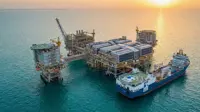Cassini’s 20-year space odyssey to end in September
11 May 2017
The Cassini spacecraft is set to end its lifespan in September this year, after spending the past 20 years in space – twelve and a half of which were dedicated to studying Saturn and its system of moons.
The probe will dive into the planet's atmosphere, after it completes the current ''Grand Finale'' stage, the final phase of its mission descending into the space between the planet in 22 weekly orbits around Saturn.
The spacecraft will not only explore this region of Saturn, something not done before, it will also use this opportunity to study Saturn's hexagonal polar jet stream in greater detail.
This persistent storm, raging around Saturn's northern polar region, had interested scientists since long, but now that it enjoyed full sunlight, the spacecraft will image it with every pass made over the planet's north pole.
The massive storm with each side measuring about 13,800 km (8,600 miles) in length, was first identified in images sent back by the Voyager 1 and Voyager 2 missions, which flew by Saturn in 1980 and 1981, respectively.
The storm is also known to rotate with a period of 10 hours 39 minutes and 24 seconds, which is assumed to be equal to the rotation of Saturn's interior.
Meanwhile, according to experts, during the 13 years of Cassini's Saturnian odyssey, a number of major discoveries regarding life-in-the-universe were made, including what NASA's head of planetary science, Jim Green called, "the two ends of the spectrum in the search for life."
At one end of the spectrum lay Enceladus - a small, highly-reflective body, that was in the news after all of the necessary ingredients for life were detected in plumes shooting out of its southern pole in 2005.
"Enceladus has the conditions most like what we think reside in our deep ocean," said Green in an interview with Astrobiology Magazine. "There may be life there - perhaps like life we've seen on Earth."
At the other end of the spectrum, lay another potentially habitable environment - Titan. According to Green, Titan, the second-largest moon in the Solar System, had methane rain and giant hydrocarbon lakes of unmapped depth.
But life on Titan would be very different from the kind of exo-life under the ice shell of Enceladus, and totally unlike any we have ever seen before, according to scientists.






















